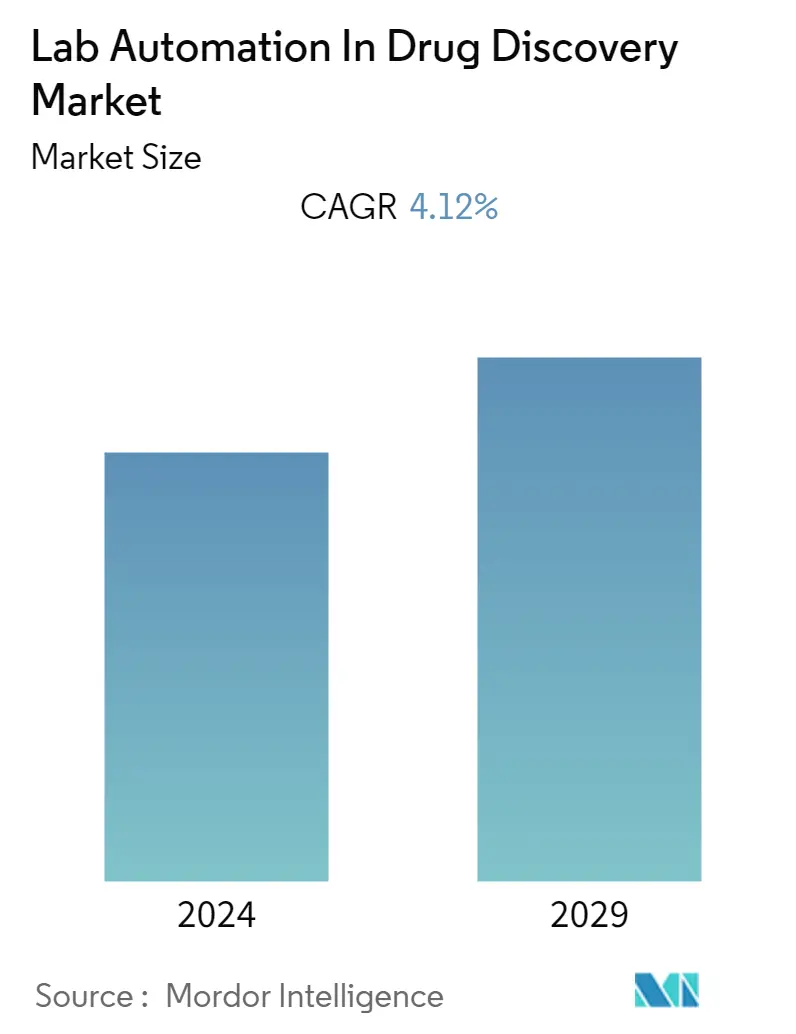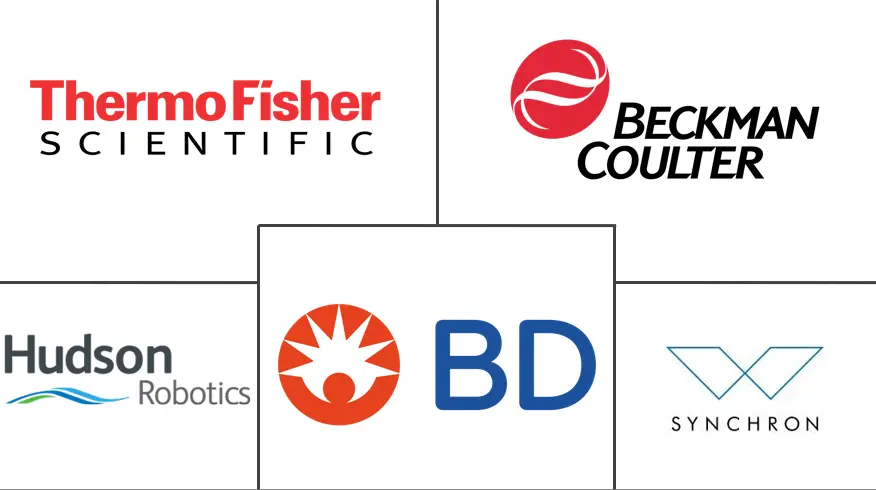Market Size of Lab Automation In Drug Discovery Industry

| Study Period | 2019 - 2029 |
| Base Year For Estimation | 2023 |
| CAGR | 4.12 % |
| Fastest Growing Market | Asia-Pacific |
| Largest Market | North America |
| Market Concentration | Medium |
Major Players
*Disclaimer: Major Players sorted in no particular order |
Lab Automation in Drug Discovery Market Analysis
Lab automation in the drug discovery market was valued at USD 5.55 billion in the previous year and is expected to reach USD 7.28 billion while registering a CAGR of 4.12 percent during the forecast period. Drug discovery organizations have been investing massive amounts in R&D activities to develop new technologies that are expected to enhance their products. These companies invest in proteomics, drug testing, high-throughput screening, and combinational chemistry to develop an environment-friendly biotechnology reagent. Hence, such developments are expected to contribute to the growth of the market over the forecast period.
- Laboratory automation transformed drug discovery over the years, primarily through two major influential factors: error reduction and cost-benefit. Additionally, automation transformed the traditional drug discovery process by making it feasible to identify many targets through the biotechnology revolution and numerous combinatorial technologies, which fueled compound collection. Additionally, drug research companies require complete solutions, dedicated customer care, and realizing their value for huge investments. Furthermore, research laboratories expect maximum software flexibility so they can configure it themselves.
- The United States has been a pioneer in clinical research for years. This country is a hub for some prominent pharmaceutical companies, like Pfizer, Novartis, J&J, GlaxoSmithKline, and Novartis. The country also possesses the highest contract research organizations (CROs) concentration. Some of the significant CROs in the country are IQVIA, Laboratory Corp. of America Holdings, Syneos Health, and Parexel International Corp. Due to the presence of such prominent players in the industry and stringent FDA regulations, the studied market is very competitive in the country. Companies in the country are adopting robotics and automation in labs to gain an advantage over competitors.
- Furthermore, the journey in drug discovery laboratories has inclined to focus on speed and accuracy. Therefore, automation of biological assays is becoming the primary factor for HTS as the labs are mainly required to screen a large number of compounds, approximately 1-3 million.
- However, one of the significant challenges that act as a hurdle in the uptake of automation in pharmaceuticals has been the interdisciplinary nature of the problem. For instance, expertise in traditional chemometrics analysis is needed, as well as advanced instrumentation, potentially new sampling or robotics methods, and knowledge of the most recent developments in machine learning (ML) and artificial intelligence (AI) approaches. In addition to this, the use of automation in laboratories can result in issues with compliance and regulations as automation can introduce errors or incorrect data into the lab environment, further increasing the probability of potential for incorrect results or non-compliance with regulations.
- On the contrary, the pandemic positively impacted the need for lab automation in drug discovery laboratories. The spread of COVID-19 and SARS-COV-2 increased the pressure on drug manufacturers to develop vaccines to combat the spread of the virus across the world. Therefore, the production contracted with major COVID-19 vaccine players increased for players, including Moderna, Johnson & Johnson, & AstraZeneca, and Catalent. Thus driving the demand for lab automation across vaccine drug manufacturers.
Lab Automation in Drug Discovery Industry Segmentation
The use of instrumentation to perform laboratory activities with minimum human involvement is known as lab automation. Automation can be used for any part of an experimental process, from a single step to the full workflow. Lab automation is divided into three stages: pre-analytical, analytical, and post-analytical. Automated processes can be applied to all aspects of the experimental process.
Lab automation in the drug discovery market is segmented by equipment (automated liquid handlers, automated plate handlers, robotic arms, automated storage and retrieval systems (AS/RS), software, and analyzers) and by geography. The market sizes and forecasts are provided in terms of value in USD for all the above segments.
| By Equipment | |
| Automated Liquid Handlers | |
| Automated Plate Handlers | |
| Robotic Arms | |
| Automated Storage & Retrieval Systems (AS/RS) | |
| Software | |
| Analyzers |
| By Geography | |
| North America | |
| Europe | |
| Asia-Pacific | |
| Rest of the World |
Lab Automation In Drug Discovery Market Size Summary
The lab automation in drug discovery market is experiencing significant growth, driven by advancements in technology and increased investments in research and development. Companies are focusing on developing new technologies to enhance drug discovery processes, including proteomics, drug testing, high-throughput screening, and combinatorial chemistry. Automation has transformed traditional drug discovery by reducing errors and costs, enabling the identification of multiple targets, and facilitating the screening of large compound libraries. The demand for automated solutions is further fueled by the need for speed and accuracy in drug discovery, particularly in the context of vaccine development during the COVID-19 pandemic. However, challenges such as the interdisciplinary nature of automation, compliance issues, and the need for expertise in advanced technologies like machine learning and artificial intelligence remain hurdles to widespread adoption.
North America, particularly the United States, is a key region in the lab automation market due to its concentration of pharmaceutical companies and contract research organizations. The presence of major players and significant investments in drug discovery contribute to the region's competitive landscape. The market is characterized by strong competition among key players like Thermo Fisher Scientific, Beckman Coulter, and Synchron Lab Automation, who are continuously innovating to maintain their competitive edge. The introduction of advanced automated liquid handlers and integrated laboratory automation platforms is enhancing lab standardization, speed, and data integrity. These developments are supported by strategic partnerships, mergers, and acquisitions, as well as the integration of AI and machine learning technologies, which are expected to drive further growth in the market.
Lab Automation In Drug Discovery Market Size - Table of Contents
-
1. MARKET INSIGHTS
-
1.1 Market Overview
-
1.2 Industry Attractiveness - Porter's Five Forces Analysis
-
1.2.1 Bargaining Power of Suppliers
-
1.2.2 Bargaining Power of Buyers
-
1.2.3 Threat of New Entrants
-
1.2.4 Threat of Substitute Products and Services
-
1.2.5 Intensity of Competitive Rivalry
-
-
1.3 Industry Value Chain Analysis
-
1.4 Assessment Of Impact Of COVID-19 On The Market
-
1.5 Technology Overview
-
1.5.1 Technology Snapshot
-
1.5.2 Industry Applications
-
-
-
2. MARKET SEGMENTATION
-
2.1 By Equipment
-
2.1.1 Automated Liquid Handlers
-
2.1.2 Automated Plate Handlers
-
2.1.3 Robotic Arms
-
2.1.4 Automated Storage & Retrieval Systems (AS/RS)
-
2.1.5 Software
-
2.1.6 Analyzers
-
-
2.2 By Geography
-
2.2.1 North America
-
2.2.2 Europe
-
2.2.3 Asia-Pacific
-
2.2.4 Rest of the World
-
-
Lab Automation In Drug Discovery Market Size FAQs
What is the current Lab Automation in Drug Discovery Market size?
The Lab Automation in Drug Discovery Market is projected to register a CAGR of 4.12% during the forecast period (2024-2029)
Who are the key players in Lab Automation in Drug Discovery Market?
Thermo Fisher Scientific, Beckman Coulter, Hudson Robotics, Becton Dickinson and Synchron Lab Automation are the major companies operating in the Lab Automation in Drug Discovery Market.

